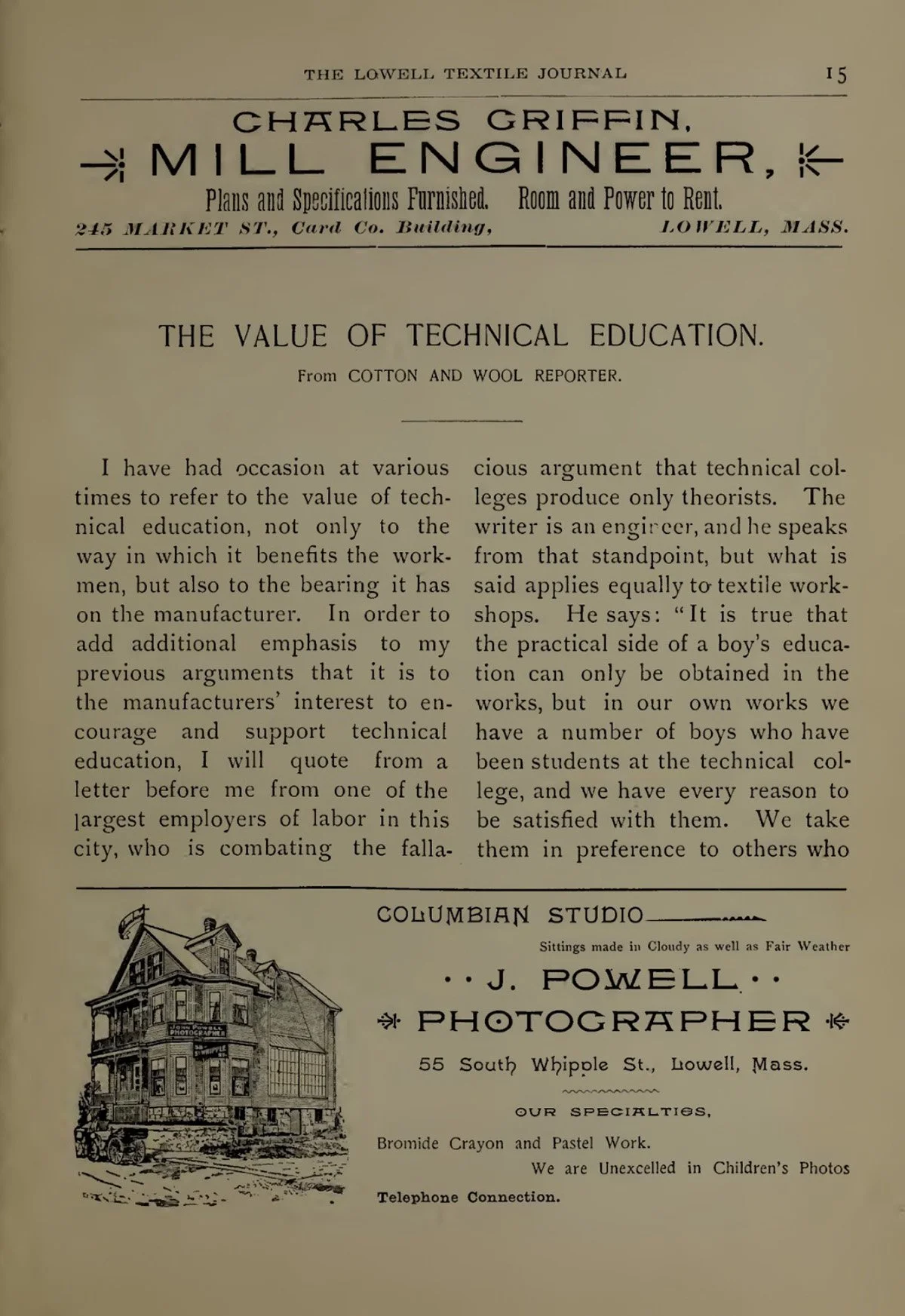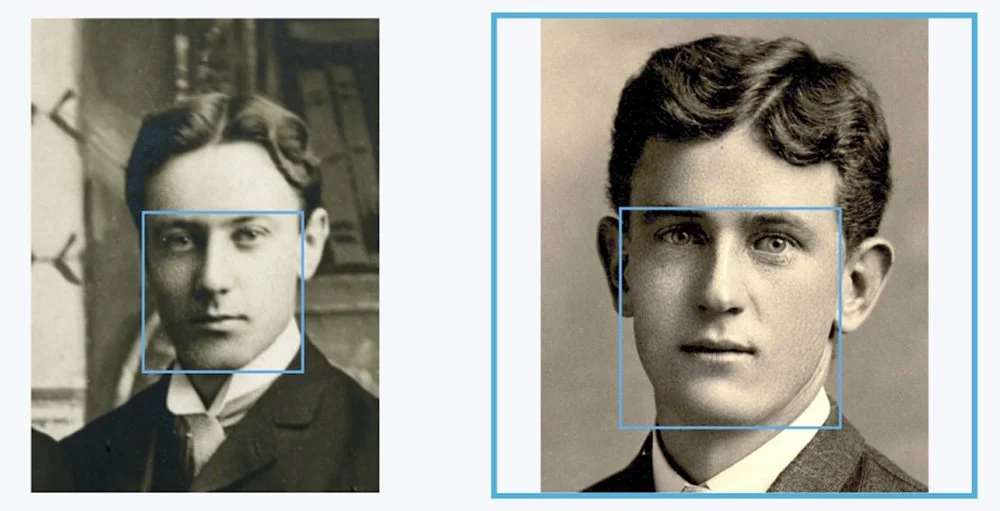To celebrate Annie’s work in and around Lowell, we’ve launched the 100 Posters Project. We are currently in the process of distributing 100 posters to local businesses, nonprofits and government agencies that now occupy buildings or have addresses on streets that Annie photographed one-hundred years ago. Our goal is to show how Lowell neighborhoods appeared in Annie’s time in relation to Lowell today.
Testing with facial recognition software suggests with the highest probability that the two men above are both Samuel Johnson, Textile School Class of 1903. The by Annie Powell nonprofit owns the image at the right.About the 100 Posters Project
Source: Lowell Textile School attributed to John Powell (1857-1928), circa 1902 • Courtesy of Kheel Center, Cornell UniversityPoster 7 of 100
Annie Powell & her Textile School Friends
The woman in the center of the above circa 1902 image is Annie Powell, then in her early 40s.
At the far left is her husband, John Powell, two years her senior. His right hand tucked inside his coat pocket hides a secret. It’s likely he’s squeezing a pneumatic tube in order to snap the shutter as cameras to take the photograph. At that time cameras had no self-timing function and photographers wishing to pose for a photo had to use a tube tethered to the camera. This kind of self-portrait is the forerunner of today’s digital selfie. We can identify three other subjects in the photograph, but the occasion for which this portrait was taken remains a mystery.
The Powells’ home and photo studio was located nearly two miles from Lowell's business district and was not convenient to downtown. Instead, we believe this group portrait was taken at the Lowell Textile School located on Middle Street in the heart of downtown where the Powells may have had a second studio on one of its five floors. Founded in 1895, the Lowell Textile School later became part of the University of Massachusetts Lowell campus.
The second studio allowed the Powells to take machinery photos and yearbook-style portraits of students and staff. They offered large-scale portraits as well. The by Annie Powell Foundation has acquired four such portraits, including one of Katherine Burrage. Burrage was the textile school’s first woman graduate and also a member of its inaugural graduating class of 1899. The foundation also owns another photograph an unidentified woman graduate from the following year.
The painted trompe l’oeil backdrop and corresponding props, such as a distinctive wicker chair, were found in other photographs by the Powells. Walk-in customers, including a local boys basketball team, must have appreciated the relative convenience of the in-town location.
Official Lowell Textile School publications thank John Powell for his photos of the mechanical infrastructure of the mills like braiders, spinning mules, and looms. The Powells often ran studio advertisements in school publications like the Textile Journal. The ads listed the address as 55 South Whipple St., suggesting that the Middle St. studio was a makeshift set up that was not fully sanctioned. See ad below.
As part of the quality control curriculum, students would have learned to take photographs of textiles and cloth. But research suggests there was no formal instruction on developing film. Curiously, the Textile Journal featured articles on film processing techniques; it is highly probably that the Powells wrote some of those articles. The school did house a darkroom, but as there was no photographer on staff, the school depended on outsiders, including the Powells, for supplies and operation.
The standing man behind Annie may explain the Powells’ close relationship with the textile school. School founder Fenwick Umpleby was seven years older than Annie, and from the same area of West Yorkshire, England. Multi-talented and the life of a party, he was popular with students and British expatriates. The Powell-Umpleby friendship was strong. In 1901, Annie joined Umpleby and his family on a steamship voyage to England to visit family. John remained in Lowell.
In the front row left, is Henry Barstow (also spelled Bastow), of the class of 1903. His is the only name listed on the back of the photo. The current owner of the image, Cornell University, noted that the photo was part of a single purchase by the Merrimack Valley Textile Museum in North Andover. As Barstow was from the adjacent town of Lawrence, it’s possible some of his descendents were involved in the sale.
We can identify a fourth person, Samuel Johnson, standing in the back row, second from right. He was Barstow’s classmate. The by Annie Powell Foundation owns a photo taken by the Powell Studio with “Samuel Johnson” written on the back. Facial recognition software was used to compare the two images and determined them to be a match of the highest probability. See image below.
This leaves us with one last question: what was the occasion of this photo? The verso (or backside) reads: “Graduation Class Lowell Textile Evening Classes 1900-1901.”
But that is surely a guess from a writer with second hand knowledge of the subjects. The actual graduation class would have been 1903 and included many more graduates. The balding man, second row, far right, is probably not a teacher and remains unidentified. However, the presence of the Powells suggests this event is more of a social gathering. According to social entries in the local newspaper of the time, Fenwick Umpleby, had a penchant for throwing lavish parties, sometimes inviting his students.
A few years after the photo was taken, the school moved to larger quarters on the north side of the Merrimack River.
Current tenants of the space include Lowell Middlesex Academy Charter School and Parker Foundation, who host this poster.
A page from the Lowell Textile Journal, 1899 featuring a display ad for John Powell Photographer.




